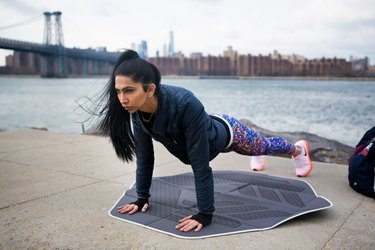
You're crushing it in Pilates or barre, holding your plank like a boss, when all of a sudden you feel your abs, arms or even legs shaking during the workout. Or maybe you're in the middle of lifting weights and your biceps start to spasm.
Freaked out — or just flat-out confused — when your muscles start shaking like a Polaroid picture? Here, an exercise physiologist explains why your muscles shake when working out.
Video of the Day
Video of the Day
Muscle Twitches 101
To understand why your muscles shake during exercise, we need to start with a little physiology lesson.
Whenever you move — whether it's with an action as simple as blinking your eyes or as complicated as coordinated a clean and jerk — it's because your brain has sent a message to your muscles telling them to work. That message goes from point A to point B thanks to motor neurons, which are located along your spinal cord, according to the American Council on Exercise (ACE).
Each motor neuron connects innervates (or talks to) a bundle of muscle fibers. When it gives them the word, the muscle cells contract or relax. Some motor neurons connect to tens or hundreds of muscle fibers and are called large motor units. Others connect to only a handful as part of small motor units.
Muscle fibers tucker out at different times, so while some fibers are at work, others are dropping out and new ones are jumping in.
Small motor neurons control slow-twitch fibers, while others control fast-twitch ones. Slow ones work during light-intensity endurance activities, like walking. They rarely tire out, yet aren't capable of producing much power.
Large motor neurons direct fast-twitch muscle fibers. Fast-twitch muscles are used during weight lifting or doing HIIT. Although they can generate tremendous force, your fast-twitch muscle fibers fatigue quickly, which explains why you can sprint for only a short period of time.
Somewhere in between slow- and fast-twitch muscle fibers are moderate fast-twitch muscle fibers.
Why Your Muscles Shake While Working Out
Now that you have a basic grasp on how your muscles twitch, let's dig into shaky muscle syndrome.
During a workout, your body recruits motor units in a systematic way. It first triggers slow-twitch motor units. As the exercise intensifies, moderate fast-twitch motor units begin to fire. Amp things up even more, and fast-twitch motor units jump aboard.
When you're hitting it hard, you'll eventually reach a point where your muscle fibers begin to flag in their subs.
"Your body adapts by replacing the fatigued fibers with fresh fibers," says Glenn Gaesser, PhD, professor of exercise physiology in the College of Health Solutions at Arizona State University.
Muscle fibers tucker out at different times, so while some fibers are at work, others are dropping out and new ones are jumping in.
Generally, your muscle fibers have the coordination down pat, which is why your motions in and out of the gym appear smooth.
But in some cases, that transition isn't so seamless. And as one fiber peaces out, it takes a split second for the other to step in, Gaesser explains. As a result, you feel your muscles shaking during the workout.
Related Reading
The 2 Times Your Muscles Are Most Likely to Shake
1. Sustained Max Exercise
Giving it your all can lead to muscles shaking while working out. During sustained strenuous exercise, you're demanding extra effort from your muscle fibers, which means a greater number of them become exhausted and call it quits, Gaesser says.
For instance, in a bench press, each time you add weight to the bar, your body has to activate more motor neurons to stimulate additional muscle fibers, while those in use are retiring at a faster pace.
Muscle twitching is also very common during isometric exercise, in which you hold a position for an extended stretch of time, as in a plank or wall sit. The longer you hold the position, the more muscle fibers drop off.
2. New Moves
"During an unfamiliar activity, particularly one that involves heavy weights, your motor units might lack coordination," Gaesser says. "With enough practice and repetition, the motor neurons will learn the skill and be able to produce a nice, smooth movement."
So if you do certain exercises on the reg, you're less likely to have shaky, quaky muscles when you do them than when you mix in a new move.
How to Stop Your Muscles From Shaking During Your Workouts
To be clear, quivering muscles aren't bad for you. "There is no danger unless you are doing [heavy] lifting, in which case it's an indication that you need a spotter," Gaesser says.
That said, it's also not necessary to push yourself to the breaking point. "Studies show that you don't have to exercise to failure in order to get fitter," he says. "The best remedy for shaking muscles is to go through a habituation period, where you gradually build up the intensity and duration of physical activity."
The bottom line: The more practiced you are at exercise, the less likely your muscles are to shake. And if they do wobble, it's a sign you should back off and give yourself a break, he says.
Should you ever be concerned about muscle shaking? "Typically, trembling subsides within a few minutes of stopping the activity, in which case it's nothing to worry about," he says.
Warning
If you have tremors or twitches for hours after exercise, it might be indicative of an underlying problem, Gaesser says. In that case, consult your doctor to check what the issue might be.
Was this article helpful?
150 Characters Max
0/150
Thank you for sharing!
Thank you for your feedback!
Is this an emergency? If you are experiencing serious medical symptoms, please see the National Library of Medicine’s list of signs you need emergency medical attention or call 911.